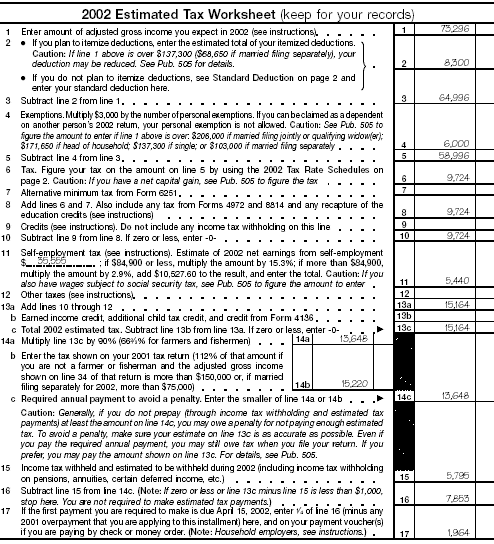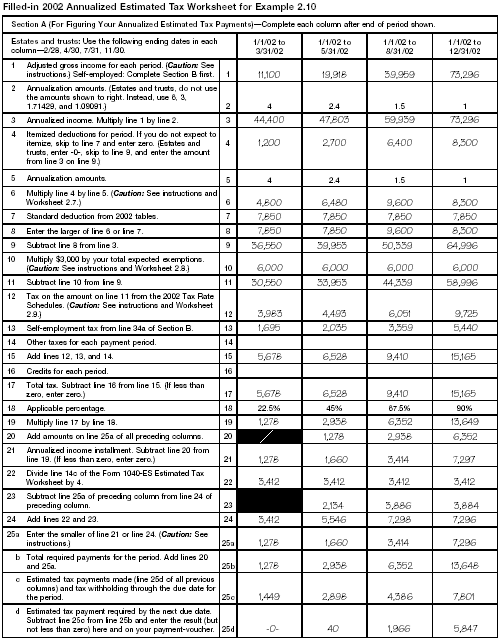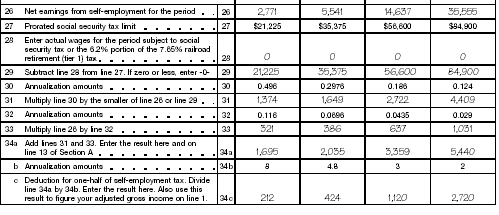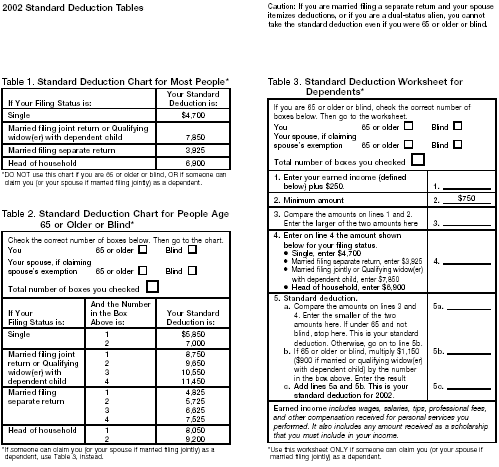How To Pay Estimated Tax
There are five ways to pay estimated tax.
- By crediting an overpayment on your 2001 return to your 2002 estimated tax.
- By sending in your payment with a payment-voucher from Form 1040-ES.
- By paying electronically using the Electronic Federal Tax Payment System (EFTPS). For EFTPS information, call
1-800-945-8400 or 1-800-555-4477.
- By electronic funds withdrawal (direct debit) if you are filing Form 1040 or Form 1040A electronically.
- By credit card using a pay-by-phone system.
In addition, if you are a beneficiary of an estate or trust, and the trustee elects to credit 2002 trust payments of estimated tax to you, you
can treat the amount credited as paid by you on January 15, 2003.
Crediting an Overpayment
When you file your Form 1040 or Form 1040A for 2001 and you have an overpayment of tax, you can apply part or all of it to your estimated tax for
2002. On line 69 of Form 1040, or line 44 of Form 1040A, write the amount you want credited to your estimated tax rather than refunded. The amount you
have credited should be taken into account when figuring your estimated tax payments.
You can use all the credited amount toward your first payment, or you can spread it out in any way you choose among any or all of your payments.
If you ask that an overpayment be credited to your estimated tax for the next year, the payment is considered to have been made on the due date of
the first estimated tax installment (April 15 for calendar year taxpayers). You cannot have any of that amount refunded to you after that due date
until the close of that tax year. You also cannot use that overpayment in any other way after that date.
Example 2.8.
When Kathleen finished filling out her 2001 tax return, she saw that she had overpaid her taxes by $750. Kathleen knew she would owe additional tax
in 2002. She credited $600 of the overpayment to her 2002 estimated tax and had the remaining $150 refunded to her.
In September, she amended her 2001 return by filing Form 1040X, Amended U.S. Individual Income Tax Return. It turned out that she owed
$250 more in tax than she had thought. This reduced her 2001 overpayment from $750 to $500. Because the $750 had already been applied to her 2002
estimated tax or refunded to her, the IRS billed her for the additional $250 she owed, plus penalties and interest. Kathleen could not use any of the
$600 she had credited to her 2002 estimated tax to pay this bill.
Using the Payment-Vouchers
Each payment of estimated tax must be accompanied by a payment-voucher from Form 1040-ES. If you made estimated tax payments last year, you
should receive a copy of the 2002 Form 1040-ES in the mail. It will have payment-vouchers preprinted with your name, address, and social
security number. Using the preprinted vouchers will speed processing, reduce the chance of error, and help save processing costs.
If you did not pay estimated tax last year, you will have to get a copy of Form 1040-ES from the IRS. See chapter 5. After you make your
first payment, a Form 1040-ES package with the preprinted vouchers will be mailed to you. Follow the instructions in the package to make sure
you use the vouchers correctly.
Use the window envelopes that came with your Form 1040-ES package. If you use your own envelopes, make sure you mail your payment-vouchers to
the address shown in the Form 1040-ES instructions for the place where you live.
 Do not use the address shown in the Form 1040 or Form 1040A instructions.
Do not use the address shown in the Form 1040 or Form 1040A instructions.
If you file a joint return and you are making joint estimated tax payments, please enter the names and social security numbers on the payment
voucher in the same order as they will appear on the joint return.
Change of address.
You must notify the IRS if you are making estimated tax payments and you changed your address during the year. You must send a clear and concise
written statement to the IRS Center where you filed your last return and provide all of the following:
- Your full name (and your spouse's full name),
- Your signature (and spouse's signature),
- Your old address (and spouse's old address if different),
- Your new address, and
- Your social security number (and spouse's social security number).
You can use Form 8822,
Change of Address, for this purpose.
You can continue to use your old pre-printed payment-vouchers until the IRS sends you new ones. However, do not correct the address on
the old voucher.
Payment by Electronic Funds Withdrawal
You can make a 2002 estimated tax payment when you electronically file your 2001 Form 1040 or Form 1040A by authorizing an electronic funds
withdrawal (direct debit) from your checking or savings account. Whether or not you have a balance due on your electronically filed tax return, you
can schedule one estimated tax payment with an effective date of April 15, 2002, June 17, 2002, or September 16, 2002. Do not send in a
Form 1040-ES payment voucher when you schedule an estimated tax payment by electronic funds withdrawal.
Payment by Credit Card
You can use your American Express® Card, Discover® Card, or MasterCard® card to make estimated tax payments. Call toll free or access
by Internet one of the service providers listed below and follow the instructions of the provider. Each provider will charge a convenience fee based
on the amount you are paying. You can find out what the fee will be by calling the provider's toll-free automated customer service number or visiting
the provider's Web Site shown below.
PhoneCharge, Inc.
1-888-ALLTAXX (1-888-255-8299)
1-877-851-9964 (Customer Service)
www.1888ALLTAXX.com
Official Payments Corporation
1-800-2PAY-TAX (1-800-272-9829)
1-877-754-4413 (Customer Service)
www.officialpayments.com
See the Form 1040-ES instructions for more information.
Illustrated Examples
The following examples show how to figure estimated tax payments under the regular installment method and under the annualized income installment
method.
Example 2.9: Regular Installment Method
Early in 2002, Anne and Larry Jones figure their estimated tax payments for the year. They expect to receive the following income during 2002:
| Larry's salary |
$29,200 |
| Unemployment compensation |
600 |
| Anne's net profit from self-employment |
38,500 |
| Net rental income |
2,671 |
| Interest income |
2,300 |
| Dividends |
3,745 |
| Total |
$77,016 |
They also use the following expected items to figure their estimated tax:
| Adjustment to income for IRA contributions |
$ 1,000 |
| Itemized deductions |
8,300 |
| Deduction for exemptions ($3,000 × 2) |
6,000 |
| 2001 total tax |
15,220 |
| Withholding |
5,795 |
The Joneses plan to file a joint return. They use the 2002 Estimated Tax Worksheet included in Form 1040-ES to figure their
estimated tax payments. Their filled-in worksheet follows this discussion.
Expected adjusted gross income.
Anne can claim an income tax deduction for one-half of her self-employment tax as a business expense. So before the Joneses figure their expected
adjusted gross income, they figure Anne's expected self-employment tax, as follows:
Filled-in Worksheet 2.2 for Anne Jones (Example 2.9)
| 1. |
Enter your expected income and profits subject to self-employment tax |
$38,500 |
| 2. |
Multiply the amount on line 1 by .9235 |
$35,555 |
| 3. |
Multiply the amount on line 2 by .029 |
$1,031 |
| 4. |
Social security tax maximum income |
$84,900 |
| 5. |
Enter your expected wages (if subject to social security tax) |
-0- |
| 6. |
Subtract line 5 from line 4 |
$84,900 |
| Note. If line 6 is zero or less, enter -0- on line 8 and skip to line 9. |
| 7. |
Enter the smaller of line 2 or line 6 |
$35,555 |
| 8. |
Multiply the amount on line 7 by .124 |
$4,409 |
| 9. |
Add line 3 and line 8. Enter the result here and on line 11 of your 2002 Estimated Tax Worksheet |
$5,440 |
| 10. |
Multiply the amount on line 9 by .50. This is your deduction for one-half of your self-employment tax |
$2,720 |
The Joneses enter $35,555 on the dotted line and $5,440 in the blank on line 11 of the worksheet. They subtract one-half of that amount, $2,720,
and their $1,000 adjustment for IRA contributions from their $77,016 total income to find their expected adjusted gross income, $73,296. They enter
that amount on line 1 of the worksheet.
Expected taxable income.
The Joneses find their standard deduction, $7,850, in the 2002 Standard Deduction Tables. This is smaller than their expected itemized
deductions, so they enter $8,300 on line 2 of the worksheet. They subtract the amount on line 2 from the amount on line 1 and enter the result,
$64,996, on line 3. They enter their deduction for exemptions, $6,000, on line 4. After subtracting this amount, their expected taxable income on line
5 is $58,996.
Expected taxes and credits.
The Joneses use the 2002 Tax Rate Schedule Y-1 at the end of this chapter to figure their expected income tax, and enter $9,724 on
line 6 of the worksheet. They do not expect to owe any other taxes that would be entered on lines 7 or 12, or have any credits that would be entered
on lines 9 or 13b, so they leave those lines blank.
The Joneses' total expected tax on line 13c, after adding Anne's self-employment tax, is $15,164.
Estimated tax.
The Joneses multiply their total expected tax by 90% and enter $13,648 on line 14a of the worksheet. They enter their 2001 tax on line 14b. Their
required annual payment on line 14c is the smaller amount, $13,648.
They enter Larry's expected withholding, $5,795, on line 15 and subtract it from their required annual payment. Their estimated tax on line 16 is
$7,853.
Required estimated tax payment.
The Joneses' first estimated tax payment is due April 15, 2002. They enter one-fourth of their estimated tax, $1,964, on line 17 of the worksheet
and on their Form 1040-ES payment-voucher due April 15. They mail the voucher with their payment to the address shown for their area in the Form
1040-ES instructions, and record the payment on the Record of Estimated Tax Payments in the instructions.
If their estimated tax does not change during the year, the Joneses also will pay $1,963 estimated tax by June 17 and September 16, 2002, and
January 15, 2003.
Example 2.10: Annualized Income Installment Method
The facts are the same as in Example 2.9, except that the Joneses do not expect to receive their income evenly throughout the year. Anne
expects to receive the largest portion of her self-employment income during the last few months of the year, and the Joneses' rental income is from a
vacation home rented only in the summer months.
After completing their 2002 Estimated Tax Worksheet, the Joneses decide to use the annualized income installment method to see if they
can pay less than $1,964 estimated tax for one or more payment periods. They complete the 2002 Annualized Estimated Tax Worksheet
(Worksheet 2.10) in this chapter. Their filled-in worksheet follows their filled-in 2002 Estimated Tax Worksheet at the end of
this example.
First Period
On April 1, 2002, the Joneses complete the first column of the worksheet for the period January 1 through March 31. They had the following income
for the period:
| Larry's salary |
$ 6,900 |
| Unemployment compensation |
600 |
| Anne's net profit from self-employment |
3,000 |
| Net rental income |
-0- |
| Interest income |
500 |
| Dividends |
462 |
| Total |
$11,462 |
They also take into account the following items for the period:
| Adjustment to income for IRA contributions |
$ 150 |
| Itemized deductions |
1,200 |
| Withholding |
1,350 |
Annualized adjusted gross income.
Before the Joneses figure their adjusted gross income for the period, they first figure Anne's self-employment tax in Section B, and then her
adjustment to income for self-employment tax.
On line 26 of Section B, they enter $2,771, which is Anne's net profit from self-employment for the period, $3,000, multiplied by .9235. The
prorated social security tax limit is preprinted on line 27. She has no social security wages, so they enter zero on line 28, and $21,225 on line 29.
Anne's annualized social security tax on line 31 is $1,374, ($2,771 × .496). Her annualized medicare tax on line 33 is $321 ($2,771 ×
.116). Her total annualized self-employment tax on line 34a is $1,695. They enter that amount on line 13 of Section A.
The Joneses figure their adjustment to income for Anne's self-employment tax on lines 34b and 34c. They figure the amount to be $212 ($1,695
÷ 8). They subtract that amount and their $150 IRA contributions from their $11,462 total income and enter their adjusted gross income for the
period, $11,100, on line 1 of Section A. They multiply that amount by 4 and enter their annualized adjusted gross income, $44,400, on line 3.
Annualized taxable income.
The Joneses figure their annualized itemized deductions ($1,200 × 4) on lines 4 through 6 of Section A. Because the result is smaller than
their standard deduction, they enter their $7,850 standard deduction on line 8. After subtracting that amount and their $6,000 deduction for
exemptions, the Joneses' annualized taxable income on line 11 is $30,550.
Annualized taxes and credits.
The Joneses use the 2002 Tax Rate Schedule Y-1 at the end of this chapter to figure their annualized income tax, $3,983, on line
12 of Section A.
The Joneses have no other taxes or credits for the period that would be entered on lines 14 or 16, so they leave those lines blank and enter $5,678
($3,983 + $1,695) on lines 15 and 17. This is their annualized total tax.
Required estimated tax payment.
The Joneses' annualized income installment on line 21 of Section A is $1,278 ($5,678 × 22.5%). On lines 22 and 24 they enter $3,412,
one-fourth of their $13,648 required annual payment under the regular installment method of figuring estimated tax payments (from line 14c of the
2002 Estimated Tax Worksheet). Because $1,278 is smaller, they enter that amount on lines 25a and 25b.
Larry's total expected withholding for the year is $5,795. The Joneses can treat one-fourth of that amount, $1,449, as paid on April 16, or they
can choose to use Larry's actual withholding for the period, $1,350. The Joneses enter $1,449 on line 25c.
On line 25d, the Joneses' required estimated tax payment for the period under the annualized income installment method is $0 ($1,278 -
$1,449). They do not have a Form 1040-ES payment-voucher due April 15, 2002.
Second, Third, and Fourth Periods
After the end of each remaining payment period, the Joneses complete the column of the worksheet for that period (from the beginning of the year
through the end of that payment period) in the same way they did for the first period. They had the following income for each period:
| |
Second Jan. 1- May 31 |
Third Jan. 1- Aug. 31 |
Fourth Jan. 1- Dec. 31 |
| Larry's salary |
$11,800 |
$19,200 |
$29,200 |
| Unemployment compensation |
600 |
600 |
600 |
| Anne's net profit from self-employment |
6,000 |
15,850 |
38,500 |
| Net rental income |
668 |
2,671 |
2,671 |
| Interest income |
850 |
1,450 |
2,300 |
| Dividends |
674 |
1,708 |
3,745 |
| Total |
$20,592 |
$41,479 |
$77,016 |
They also take into account the following items for each period:
| |
Second Jan. 1- May 31 |
Third Jan. 1- Aug. 31 |
Fourth Jan. 1- Dec. 31 |
| Adjustment to income for IRA contributions |
$ 250 |
$ 400 |
$1,000 |
| Itemized deductions |
2,700 |
6,400 |
8,300 |
For the second period, as for the first, the annualized income installment method allows the Joneses to pay less than their required payment under
the regular installment method of figuring estimated tax payments. They make up the difference in the third and fourth periods when their income is
higher.
Because the Joneses are using the annualized income installment method, they will file Form 2210 with their tax return for 2002.

Filled-in Worksheet for Example 2.9

Filled-in Annualized Estimated Tax WorksheetsEstimated tax Annualized income installment method Filled-in worksheet

Filled-in Annualized Est Tax Worksheets and 2002 Tax Rate Schedules

Standard Deduction Tables
Previous | First | Next
Publication Index | 2002 Tax Help Archives | Tax Help Archives | Home

 Do not use the address shown in the Form 1040 or Form 1040A instructions.
Do not use the address shown in the Form 1040 or Form 1040A instructions.



